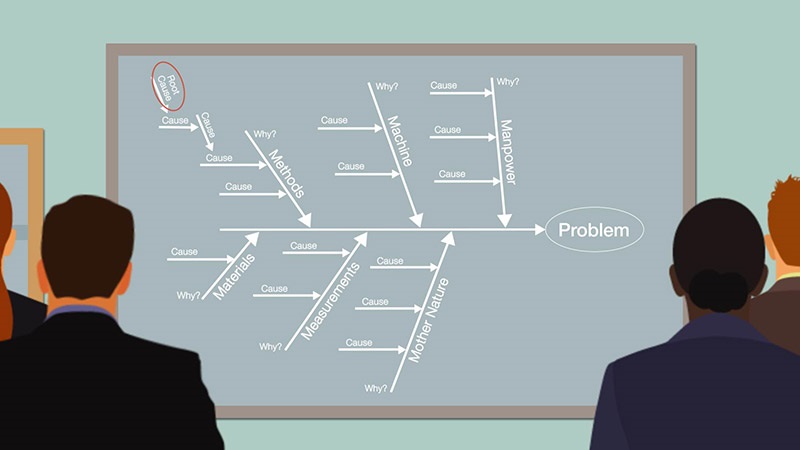Root Cause Analysis (RCA) is a pragmatic, logical, common sense type approach. It is a simple process of “Have a problem” > “Find the cause” > “Prevent the effect”. Yet, surprisingly, one is more likely to see firefighting and band aid fixes being applied over and over again, than to find organizations applying their minds to real problem solving . Perhaps there is a misconceived notion that RCA is resource intensive and complex, but by using the Ishikawa, or ‘Fishbone’ Diagram, it can be simple, efficient and effective.
Implementing and utilizing the Fishbone as a tool for RCA is a straight forward exercise, and one only needs to follow the few steps as I have outlined below -
Identify the Effect (Problem) – the first thing that you need to do is define the effect, aka the problem statement, or in other words ‘what is the problem the organization is facing? ’ Write this down in the middle of a sheet or board, on the far right, and draw a box around it. Then add a horizontal line all the way from the left to, with an arrowhea d at the end going into the box, so it’s pointing at the problem statement.
An example of an effect could be: The wheels on the car keeping falling off after 5km of road testing
(Now I am no gambler but I bet that any car manufacturer would want to know what’s causing that!)
Choose the Cause Categories – the next thing to do is to add the categories of causes of the effect or problem as (fish) bones or branches to the diagram. These are normally customized based on your industry vertical, or even the effect itself, but typically the Six M’s are used as a common starting point:
- Methods (what policies, processes and procedures were used)
- Machines (what equipment and tools were used)
- Manpower (which human resources and roles were used)
- Materials (what raw or input materials were used)
- Measurement (what process information is available for quality assessment)
- Mother Nature/Environment (what were the operating conditions and culture)
Figure out the Causes – then, proceeding category by category, work with your stakeholders to brainstorm and come up with all possible and more probable causes, and add these to the Fishbone diagram (bone by bone – it will fast become a fish you wouldn’t want to order at your local restaurant)
Example of a Cause could be:
(Category) Machines – the wheel bolts were not tightened enough by Machine ABC
And their Sub Causes – once all the suspected causes have been identified think about the causes of the causes… and repeat, all the way until the lowest possible level of cause (root) has been reached, and add these to the Fishbone
Action – set actions in motion and implement these to create solutions which will plug the root cause/s!
Simple enough. The great thing about the Fishbone, besides yielding results each and every time, is that its use can be augmented or supplemented with other techniques for helping to get to the root causes…
Take the 5 Whys, from the world of Lean and Optimization, which is a technique used in the Analyze phase of Six Sigma’s DMAIC methodology. It ’s basically a drill-down technique to get to the cause of each cause so to speak, by asking ‘Why it happened ’… and through research it was determined that on average there were five layers to get to a root cause – hence 5 Whys.
Example of using the 5 Whys:
- Why did the wheels fall off?
– Because Machine ABC didn’t tighten them enough. - Why didn’t Machine ABC tighten them enough?
– Because it had a loose cylinder. - Why did Machine ABC have a loose cylinder?
– Because it was old and broken. - Why was the cylinder old and broken and not replaced?
– Because Machine ABC missed its service. - Why did it miss its service?
– Because the company ran out of money and couldn’t pay the provider.
Applying the 5 Whys is a great way to get from Causes to sub-causes and ultimately to root cause – so you can see why it works perfectly with the Fishbone: Cause and Effect approach. I recommend using these together!
Problems are everywhere, and so whether as part of a defect prevention, quality assurance, a continuous improvement program in your organization, or simply a once off to solve a specific problem, root cause analysis is a must have in your enterprise arsenal. 9 times out of 10, the solutions put in place first time around don’t solve the real problem because they just don’t address the root cause. If you’re looking for a smart, simple, results producing way to get to the (real) bottom of your problems, I can’t think of a better way that the Fishbone. As the saying goes “Unearthing the cause is half the problem solved.”
Additional reading available at: http://orbussoftware.com/business-process-analysis/lean/
Orbus Software’s iServer Business Process Improvement capabilities delivers an extensive range of built in features, reports and assessments, including useful templates for Root Cause Analysis.
